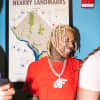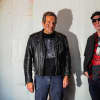 Alivia Zivich
Alivia Zivich
On the final Friday of January, the shadowy noise duo known as Wolf Eyes released Difficult Messages, a compilation album of rare collaborations recorded over the past several years. Comprising 11 tracks gathered from a “series of super-limited seven-inch hand-painted box sets” (per a press release), it’s a fitting way for one of modern music’s most transgressive projects — founded in the ’90s as the solo endeavor of Nate Young and soon joined by John Olson and Aaron Dilloway, the latter of whom left in the mid aughts to pursue his own uncompromising solo career — to enter its second quarter century of existence. Messages features contributions from Dilloway, Alex Moskos, Gretchen Gonzales, and Raven Chacon.
Today (February 8) on The FADER, Wolf Eyes are premiering three short clips inspired by songs from the new album. Less than traditional music videos, they’re miniature, mildly disturbing abstractions set to music, none of which adhere to the run times of the tracks whose names they bear.
“Short Hands - Dank Boone” — a sparse Young/Moskos bass/guitar creation, with hissing feedback and mumbled, punk-bluesy vocals provided by Olson — is accompanied by a series of disjointed shots that capture scenes of natural phenomena (a frozen pond, a fish fossil, lava, etc.), the fumigation of a building, Olson and Young peeling off the gory face makeup pictured above, Danny DeVito as the Penguin, and more.
“Wolf Raven - Tulsa Once” — an obliterating Chacon collab full of frantic, screaming static — gets what appears to be an iMovie montage of random stills from Olson’s camera roll, including but not limited to idyllic landscapes, a closeup on a fucked-up-looking guitar pedal, a messy desk tableau, and a portrait of a Wonder Woman-themed Cool Ranch Doritos bag.
And “Time Designer - Passive Tempos” — another Young/Moskos number that’s a case study in jittery, polyrhythmic percussion — receives the longest treatment of the group: a single, shaky-cam shot of a sunny drive around Montreal.
In addition to the new videos, Young and Olson both took the time to send The FADER some words that help to demystify some of the magic behind their Difficult Messages. Read their statements, watch the clips, and listen to the album below.
“We took a new approach to creating this album, using remote collaboration, collage, and sampling to bring together different styles and sound sources from the Wolf Eyes multiverse. We twisted and mutated these elements into something new and unnerving, like a game of musical telephone where the message becomes distorted and fragmented as it passes through different minds. The resulting sound is a chaotic patchwork that challenges the listener and ourselves to piece it all together. This technique is akin to creating Mail Art or an Exquisite Corpse. We are also delving into older Wolf Eyes concepts, such as rejecting the idea that music should be harmonious and pleasing to the ear. As we began expanding on dissonance and discomfort with this project, we had a head-on collision with Postmodernism. By utilizing [that movement’s] techniques and concepts, we were able to create work that is more open-ended and inclusive, resulting in music that will make your ears bleed and your mind reel.” —Nate Young
“Difficult Messages by Wolf Eyes is a phantasmagorical journey into a world of adhesive expression and audio alchemy. With each handmade box set, the band explores a new universe where the common canon is reinterpreted and remixed into a kaleidoscope of sound. The collaborative process — from the late-night hand-off to the obscure pressing plant with its odd, fast-paced magic — creates a carnival of personal cubism. The Michigan underworld of uncommercial seven-inch singles is a Herculean arena of boundless possibilities, a gateway to the bizarre. In this electronic folk music, there is no floor, only a carnival of shadows that mirror the grim landscapes of the mind. Join Wolf Eyes as they hand off their paintings and feelings, inviting you to participate in this raucous celebration of outsider art, the Difficult Messages.” —John Olson


